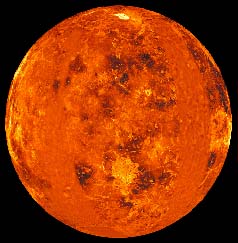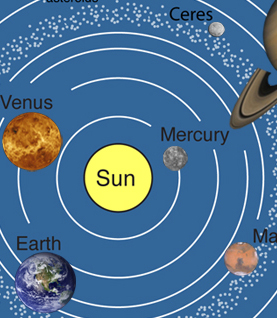Venus

|
 The brightest planet as seen from Earth, Venus swings from one side of the Sun to the other, alternating as our brilliant "Evening Star" and "Morning Star," each seen for about 8 months at a time.
|
The surface atmospheric pressure on Venus is about 92 times that on the Earth! The carbon dioxide atmosphere and sulfuric acid clouds of Venus allow sunlight in but don't let the heat back out, trapping it like the glass in a greenhouse and making Venus the hottest of planets. The flyby of Mariner 2 in 1962 indicated a surface temperature of about 400°C. One of the discoveries of Mariner 2 was that Venus has no measurable magnetic field, even though its density indicates an iron core similar to that of the Earth. The presumption is that its slow rotation (period 243 Earth days) is insufficient to create the kind of dynamo effect which produces the Earth's magnetic field.
Mariner 5 passed closer to Venus, swinging by at 2900 km. Venus was used in a slingshot maneuver to boost Mariner 10 on toward Mercury on Feb 5, 1974. Its closest approach to Venus was 5770 km. The exploration of the atmosphere and surface of Venus was a major goal of the Russian space program in their extended Venera series of spacecraft. The Venera explorations provide the only direct data we have on the surface of Venus. The Magellan orbiter provided a much more detailed radar map of the surface than the previous explorations, bringing the number of Venus exporation missions to about 20.
Solar System Illustration
Solar System Concepts
Venus Concepts
| HyperPhysics********** Astrophysics | R Nave |